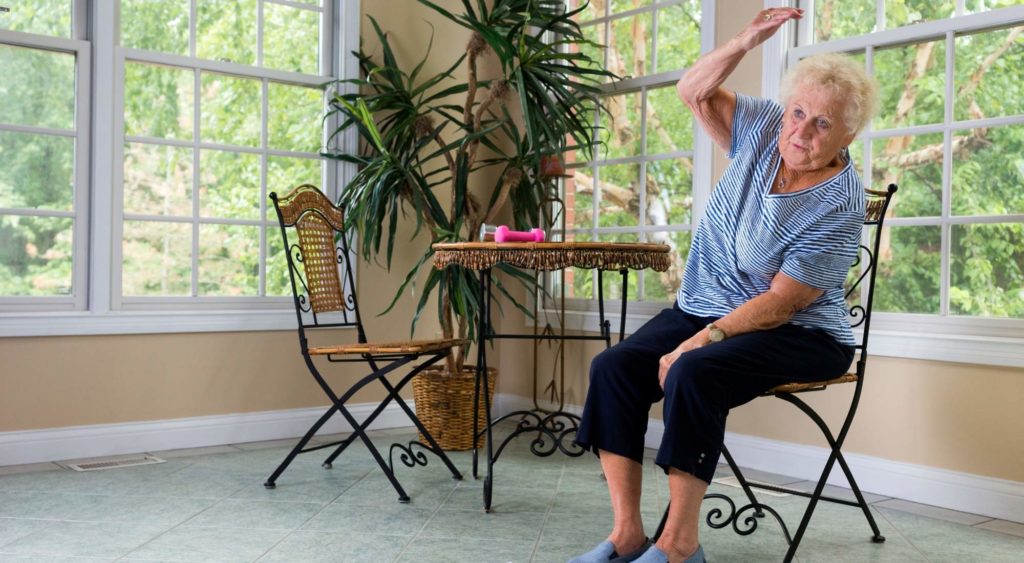
Do you need physical therapy?
If you have an injury or a condition that affects your mobility, you may wonder if you really need to see a physical therapist, or if you can just work on it at home by yourself.
After all, physical therapy appointments can take time and cost money that you may not feel like you can spare. And how do you even get started?
It isn’t difficult, and evaluation by a licensed physical therapist is the first step toward maximizing your recovery goals.
This guide will explain why seeing a physical therapist is beneficial to you, how to do physical therapy on yourself, and what steps you should take throughout the process.
Table of Contents
- Can I Do Physical Therapy On My Own?
- The 3 Dos and Don’ts of Doing Physical Therapy at Home
- Consider Your Rehabilitation Goals Before Doing Physical Therapy at Home
- Do You Need a Physical Therapist? In Motion O.C. Was Voted the #1 Physical Therapy Clinic in the U.S

Can I Do Physical Therapy On My Own?
The short answer is — yes. But that response comes with a caveat.
If you plan to look up a bunch of exercises online and try doing them whenever you can find the time, your at-home physical therapy regimen is probably not going to work very well.
Physical therapy is beneficial for a multitude of injuries and illnesses. This type of care will assist in easing your pain and serves to help your body work and move better.
And while you can do some of it on your own, you don’t want to start any sort of PT program without first consulting a licensed physical therapist.
What Can a Physical Therapist Offer That I Can’t Do Myself?
Physical therapists go through years of training to become qualified to diagnose and care for individuals of all ages.
They treat people with:
- Injuries
- Disabilities; and
- Health conditions that require management.
But they also work on people who have a desire to be healthier or are interested in preventative care.
There are many things a physical therapist can do that you should not try to handle on your own.
These include:
- Evaluating your condition — At your first meeting, a PT will do a full assessment to figure out precisely what your issues are and how they are impacting your body and movements.
- Developing a treatment plan — Physical therapists are highly trained to design a series of stretches, exercises, and remedies to correct and relieve the symptoms of your injury or condition.
- Teaching you how to perform your therapies correctly — This is an essential component of physical therapy, as doing exercises or stretches with bad form or using the wrong treatment for your pain (for instance, heat when you need ice) can make your condition worse, cause further injury, and prolong your need for care.
- Watching your progress and adjusting treatments as necessary — The great part about physical therapy is that the goal is to eventually not need it. A licensed physical therapist will be able to see what is and isn’t working and change your program to benefit you.

The 3 Dos and Don’ts of Doing Physical Therapy at Home
We aren’t saying that you should never do your own physical therapy at home. In fact, the goal of a good physical therapist should be for the client to gain independence with an increase in knowledge, tools, and progress provided by a customized program.
But if you strike out on your own and don’t follow the right guidelines, you could end up worse than where you started. Here are some dos and don’ts regarding at-home physical therapy.
#1: Don’t Push Through the Pain
It’s normal to experience some pain when doing physical therapy, but you may not be the best judge of how much is too much. A physical therapist is trained to guide you through your personal threshold of pain and advise you on exactly what you should expect.
Pushing through the pain can exacerbate your injury or even cause new ones.
Sandra recently sprained her ankle and decided to do some exercises at home for it. She asked her brother what his physical therapist had done when he had a leg injury a few years ago — she figured it had worked well for him, so why not give it a try?
The exercises hurt a lot, but Sandra assumed that must mean they were doing their job. Just like we’ve always heard, no pain, no gain!
Unfortunately, Sandra’s refusal to listen to her body caused further injury to her ankle and lengthened her recovery time.
#2: Don’t Stretch Aggressively
Stretching is an essential component of physical therapy, but doing it too hard or with incorrect form creates more harm than good.
For instance, bouncing while you stretch can cause microtears in your muscle, which leads to scar tissue. This tightens the muscle even more and leaves you less flexible and more prone to pain.
#3: Don’t Overdo It
If you push too hard, for instance doing too many sets of an exercise, you could cause setbacks in your rehabilitation.
A physical therapy treatment plan is developed with the individual patient and his or her needs in mind, including:
- What exercises are best for the condition
- How frequently they should be done; and
- When to stop doing them.
#1: Do Conservative Treatments
You don’t have to commit to a full-on exercise plan to treat yourself at home.
The types of treatments that work better for home are more conservative, such as:
- Rest
- Ice
- Heat
- Modified daily activities
- Gentle stretching
- Massage
#2: Do Your Research
If you’re in the habit of turning to “Dr. Google” for your medical needs, you have to be careful about your sources. Look for quality information from real doctors in sports and rehab medicine on how to do physical therapy at home and don’t blindly trust random bloggers or people advising on Reddit.
When Frank hurt his shoulder playing a pick-up game of basketball, he figured he would search online for the best remedies. He found a list of exercises for shoulder problems.
He wasn’t sure if he was reading a high-authority site, but the advice seemed safe and worked for many of the commenters, so why not? Turns out, Frank’s shoulder problems were worse than he originally thought and he ended up in even more pain.
So not only should you do your research, but it’s also important to have an injury diagnosed by a trained professional before beginning treatment for it.
#3: Do The Right Thing and Call a Physical Therapist
Maybe you don’t want to use a physical therapist because you feel like you don’t have time to go to appointments or you think you can’t afford the cost. These are valid concerns, but we encourage you to reach out and learn your options.
A good physical therapist will work with you and design a plan that fits your schedule and budget.
Plus you could be saving yourself time and money in the long run by correcting your condition sooner and more safely.

Consider Your Rehabilitation Goals Before Doing Physical Therapy at Home
So what do you hope to gain from physical therapy?
If you’d like to …
- accelerate your rehabilitation from an injury or condition
- greatly reduce the risk of injury while doing so; and
- benefit from a plan that is specifically tailored to your needs
… then consulting a licensed physical therapist is a must for you.
When NOT to do Physical Therapy at Home
We aren’t saying that physical therapy should never be done at home on your own, but there are cases when we strongly advise against it, such as:
- Your injury is new and your body is extremely sensitive.
- You just had surgery and are still recovering.
- Your doctor prescribed physical therapy as part of your treatment plan.
Do You Need a Physical Therapist? In Motion O.C. Was Voted the #1 Physical Therapy Clinic in the U.S.
If you are convinced that physical therapy is the way to go to help you with your goals, contact us today at In Motion O.C. and let’s get started.
We’ll provide you with:
- A free consultation.
- A plan of action tailored specifically to your needs.
- Individual sessions with a licensed physical therapist.
- Homework assignments so you can keep the progress going at home.
- Relief from your pain, injury, or weakness.



